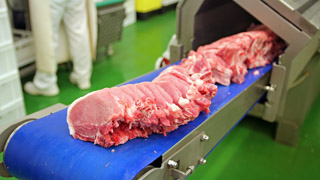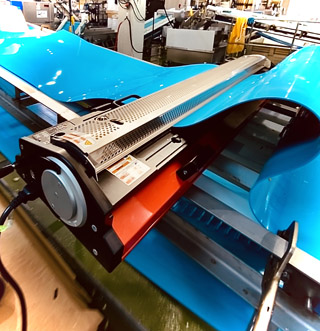Protein Industry Spotlight: Quick, Easy Splicing of Homogeneous Conveyor Belts Can Reduce Downtime
 As the Industry Manager for Food Processing here at Flexco, I have been to a lot of facilities. And while many applications are more suitable for plastic modular belting (PMB), certain processes efficiently utilize the benefits that homogeneous (monolithic) belting provides. With food compliance rules and regulations growing at an ever-increasing rate, process-related products in belting are also evolving rapidly. FDA, EU, USDA, MHLW, Halal, and NSF compliance/certification are often required for belt conveyors in these facilities, along with HACCP plans for a proactive approach to prevent possible contamination and hazards. Modular, synthetic, and homogeneous belting all support several, if not all of these concepts, yet homogeneous belting is typically the simplest and most efficient to clean, minimizing downtime and increasing revenue for the companies. I decided to ask a few operations managers about the positive impact of homogeneous belting in their facilities.
As the Industry Manager for Food Processing here at Flexco, I have been to a lot of facilities. And while many applications are more suitable for plastic modular belting (PMB), certain processes efficiently utilize the benefits that homogeneous (monolithic) belting provides. With food compliance rules and regulations growing at an ever-increasing rate, process-related products in belting are also evolving rapidly. FDA, EU, USDA, MHLW, Halal, and NSF compliance/certification are often required for belt conveyors in these facilities, along with HACCP plans for a proactive approach to prevent possible contamination and hazards. Modular, synthetic, and homogeneous belting all support several, if not all of these concepts, yet homogeneous belting is typically the simplest and most efficient to clean, minimizing downtime and increasing revenue for the companies. I decided to ask a few operations managers about the positive impact of homogeneous belting in their facilities.
What benefits do you see in using homogeneous conveyor belts in your operation?
The overwhelming response was that homogeneous belting, with its smooth, hard surfaces, was indeed very simple to clean. Several of them spoke to the level that belting manufacturers have went to with PMB module designs, which minimize crevices and pockets where soilage and bacteria can build. And on the fabric-reinforced synthetic belting side, manufacturers have innovated with more hygienic edge-sealing technology, as well as fabric weave designs to prevent wicking and fabric fraying. Most also still felt a homogenous belt’s simple design proves superior in the area of sanitation and cleaning.
I mentioned to them that when the homogeneous belts are made endless, this further enhances this benefit as there are no pin joints where crevices can trap foodstuff. This allows them to use less water and chemicals while taking less time to perform the tasks after each shift. Overall, there’s just less of a chance of harboring bacteria in the belt between cleanings.
Is plastic modular belting easier to work with?
This last part did lead to some hesitation, however, and I got some reluctant responses. Even though the cleanability is at a premium with homogeneous belting, most feel that PMB is easier to work with and if an issue occurs, it is easier to replace components, rather than replacing the entire belt. Most of them still rely on their experience that homogeneous belts require a level of expertise when it comes to making the belts endless, while anyone can remove a pin and replace a module on a PMB, which minimizes downtime. This is nothing I hadn’t heard before and to be honest, this is true when it comes to hot wand splicing of homogenous belts. But there are better ways and we’ll dive into that shortly.
Most of the managers felt that their cleaning processes were thorough and their operations were overall efficient. But I could tell I had piqued the interest of a few of my respondents, especially those who were interested in the hygienic benefits of utilizing the features of homogeneous belting.
A simplified approach
| Rethinking Hot Wand Splicing |
| Hot wand splicing was the tried and true method for one beef processing plant, until a catastrophic belt failure due to a poor quality splice caused them to rethink their methods. Find out how their belts are running now in our latest application profile. |
At Flexco, we work hard to keep up with the latest trends in various industries so we can help address any challenges our customers are facing. And right now, reduced downtime and increased sanitation are two of the bigger trends we are seeing in the proteins industry, especially when it comes to belt conveyors.
The use of homogeneous belts is an excellent way to limit downtime and improve operational sanitation, but maintenance teams often shy away from them because of the premise that splicing is tough, and in some cases, dangerous. They aren’t wrong if we’re talking about hot wand splicing. With an exposed heating element that can run up to 500 degrees F, safety isn’t the first word that comes to mind. And hot wand splicing is really a guessing game when it comes to consistency and quality – oftentimes dependent on whoever is operating the wand. Does your operation have a “go-to” employee for splicing because they are a genius with the hot wand? And what happens when that person wants to take vacation? Is it easy for someone else to step in and create consistent, quality splices? Probably not.
Hot wand splicing was the tried and true method for one beef processing plant, until a catastrophic belt failure due to a poor quality splice caused them to rethink their methods. Find out how their belts are running now in our latest application profile.
Quicker, easier splicing of homogeneous conveyor belts is possible
 |
| The Novitool® Amigo™ Homogeneous Splice Press is the solution for safer, more consistent splices. |
What if there was a tool that was so easy to use it made everyone on your maintenance team the “go-to” for splicing? What if there was a tool with an enclosed heating element that made splicing safer for your team? What if there was a tool that completed splices in approximately one minute? The Novitool® Amigo™ Homogeneous Splice Press checks all the boxes and more when it comes to quicker, easier splicing of monolithic belts.
Flexco knows that splices in homogeneous belting must ensure tight pitch tolerance and be free from pinhole air pockets. With that in mind, everything about the Amigo™ 625 and 1000 has been designed to do just that. Both presses feature an integrated blade with a single pass operation that cuts belt edges square. They are designed for operator safety from lacerations as the blade passes through the clamp bars and stores in a blade housing when complete.
When it comes time to splice, preheat mode removes the moisture from the belt ends to minimize pinholes. The contactless heating element splices the belt in as little as one minute, finishing with a controlled amount of clash. It is also stored within the press when not in use, protecting the operator from possible burns. The shielded heat zone not only provides consistent heating in various environmental conditions; it also protects the operator from the heat source during splicing. The heater stows and cools inside the press as the belt ends are brought together, fabricating the butt-weld.
While both models are easy to use, The Amigo™ 625 is even compact enough to be transported and used by one operator, with two convenient carrying handles on either side of the tool for optimal mobility.
Splicing homogeneous belts doesn’t have to be scary
| Powered Splicing Anytime, Anywhere |
| Keeping in mind that sometimes belt repair doesn’t happen in the most convenient of places, Flexco has also released requirements for power banks that can be used with our endless splicing tools. Click here for a document that lists those requirements so that you can splice belts anytime, anywhere on your system. |
While we can’t dispel all the myths that come with homogeneous belting, we certainly can reduce the downtime associated with repairing these types of belts with our offering of splicing tools. If you’re interested in learning how to get your belts up and running in a safer manner that produces quality, consistent splices, reach out to your local Flexco distributor and we’ll be happy to stop by to give you a free demo of any of our endless splicing solutions.
Authored by: Jonathan Morgan, Industry Manager – Food Processing
As an Industry Manager at Flexco, Morgan focuses on the food processing industries, including proteins, baking, and produce. Morgan has a mechanical engineering education, application knowledge, extensive industry network, and technical sales support experience.
Related Blogs
Published Date
February 08, 2022Industry
- Proteins
Issues
- Downtime
- Maintenance
- Sanitation
- Splice Consistency